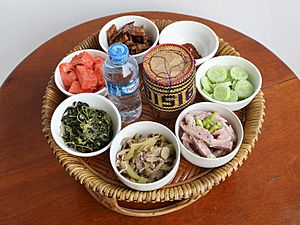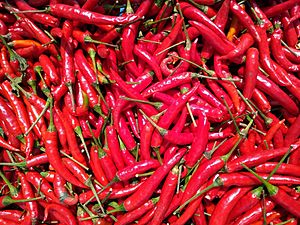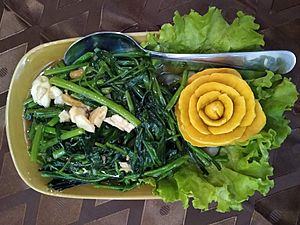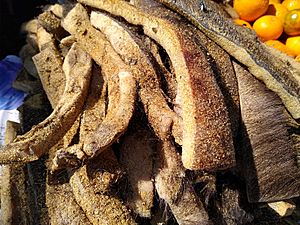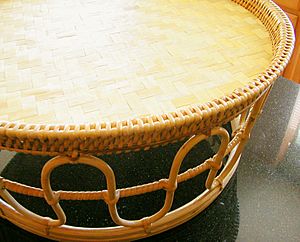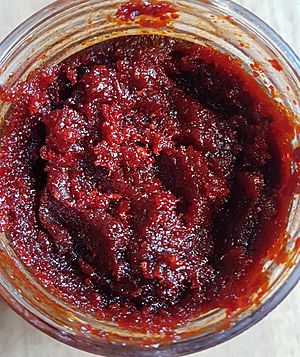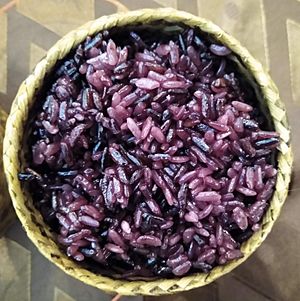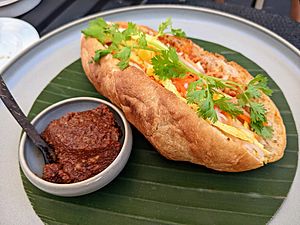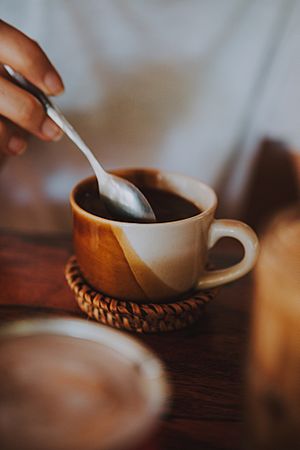Lao cuisine facts for kids
Lao cuisine or Laotian cuisine (ອາຫານລາວ) is the national food style of Laos.
The main food for the Lao is sticky rice (ເຂົ້າໜຽວ, khao niao). Laos eats more sticky rice per person than any other country. People there eat about 171 kg of sticky rice each year! Sticky rice is a huge part of Lao culture, religion, and national identity. Many Lao people believe that sticky rice connects them to their culture, no matter where they are. Being a fan of sticky rice is seen as a key part of being Lao. Often, Lao people call themselves luk khao niaow, which means 'children of sticky rice'.
The International Rice Research Institute (IRRI) calls Laos a “collector’s paradise” because it has so many different kinds of sticky rice. Laos has the most types of sticky rice in the world. By 2013, about 6,530 types of sticky rice were collected from five continents. These were saved at the International Rice Genebank. The IRRI collected over 13,500 samples and 3,200 types of sticky rice just from Laos.
The three most important foods in Laos are sticky rice, larb, and green papaya salad (ຕຳໝາກຫຸ່ງ, tam mak hoong). The most famous Lao dish is larb (ລາບ). It is a spicy mix of marinated meat or fish. Sometimes the meat is raw, like ceviche. It also has different herbs, greens, and spices.
Lao food changes a lot from one region to another. This is because each area has its own fresh foods. In the capital city, Vientiane, you can still see French influences. Baguettes (ເຂົ້າຈີ່) are sold on the street. French restaurants are also common and popular. These were first brought to Laos when it was part of French Indochina.
Contents
How Lao Food Began
The Lao originally came from a northern area that is now part of China. They brought their food traditions with them as they moved south. Because Lao people moved from Laos to nearby areas, Lao food has influenced places like Northeastern Thailand. Lao dishes also came to Cambodia and Northern Thailand where Lao people settled.
Like most countries in Southeast Asia, Laos has been greatly shaped by Indian and Chinese cultures. For a very long time, Lao people traded directly with ancient China. However, Indian culture had the biggest impact. When Hinduism, Buddhism, and Islam spread through Southeast Asia, they brought Indian traditions and food. These took root in places like Indonesia, Malaysia, Thailand, Cambodia, and Laos.
During this time, Buddhist monks brought traditional Indian spices, curry, and coconut milk to Laos. But unlike its neighbors, Lao people loved sticky rice. Because of this, coconut milk and noodles never became a main part of Lao cooking. Instead, they are mostly used in a few Lao soups, noodle dishes, and sticky rice desserts.
Later, new crops like tomatoes, papayas, sweetcorn, pineapples, and chili peppers came to Southeast Asia. They likely arrived through ports in modern-day Thailand, Cambodia, and Vietnam. These new foods spread quickly through trade with the Portuguese and other Europeans.
By the mid-1500s, Europeans were already exploring and trading in mainland Southeast Asia. They reached as far as Vientiane and Luang Prabang, Laos. Many explorers wrote about their travels there. By the early 1700s, papaya was widely grown in Siam (Thailand). By 1830, papaya and chili peppers were fully part of the food culture in Laos and all of Southeast Asia.
French explorer Henri Mouhot visited Luang Prabang. He wrote that Laotians really loved chili peppers.
Lao and Thai Food
It's hard to talk about Lao food without also talking about Thailand. There are about six times more ethnic Lao people in the Isan region of northeastern Thailand than in Laos itself. This means you have to look beyond Laos to find true Lao food. Many Lao people have moved to Bangkok, Thailand's capital. Some think Bangkok has become the center of Lao food.
In the 1950s and 1960s, Lao food was not well known in central Thailand. You could only find it where Lao people or northeasterners gathered. For example, it was sold near boxing stadiums where fighters and fans ate. It was also found near construction sites and gas stations, serving workers and bus drivers from the northeast.
After the Vietnam War, from 1975 to 1995, about 200,000 Lao refugees crossed into Thailand. Many stayed in camps, while others moved to Bangkok to find work.
When the Mittraphap Road and northeastern railway opened, it connected central Thailand to its northern areas. This led to a huge move of people during the economic boom of the 1980s. Between 1980 and 1990, about 1.1 million people moved from the northeast to central Thailand and Bangkok. This helped make Lao food very popular outside of Laos and the northeast.
However, when Bangkok tried to make northeastern food part of Thai national cuisine, they changed some dishes. They reduced the chili peppers and added more sugar to dishes like grilled chicken, papaya salad, and larb. They also ignored other dishes like fermented fish and insects. These changed dishes were then presented to the world as Thai food.
Even though more ethnic Lao people live in Thailand than in Laos, and Lao food helped make Thai food popular, the word "Lao" is rarely used. This might be because of "Thaification" (1942–present). This was an official effort to promote Thai unity. Any mention of "Lao" was removed and replaced with "northeastern Thai" or "Isan."
This led to people from the northeast being treated unfairly. The word "Lao" became a negative term. Being "Lao" was seen as being uneducated and old-fashioned. This made many northeasterners ashamed to be called Lao. More recently, the negative feeling about being Lao is fading. There is now a strong sense of pride in Lao identity, especially among young people in Isan.
In Western countries, Lao food is still mostly unknown, even with many Lao people living there. Much of what is served in Thai restaurants is actually Lao or owned by Lao people. Many people don't know that when they eat their favorite som tam, larb, and sticky rice at a Thai restaurant, they are often eating Thai versions of traditional Lao food.
Lao restaurant owners sometimes advertise their places as Thai restaurants. This is because most people in America don't know Lao food. By calling themselves Thai, they attract more customers. Then, they add Lao dishes to the menu. While Lao and northern Thai food are similar, a true Lao-owned restaurant will usually have sticky rice on the menu.
One of the first Thai restaurants in North America was opened by Keo Sananikone. He was a Lao refugee and an early person to bring Thai food to the US. In 1977, Keo opened several Thai restaurants in Hawaii. These became popular with Hollywood stars. Keo later wrote a best-selling Thai cookbook. He explained that he opened Thai restaurants instead of Lao ones because he felt Lao food was "very basic and simple," while Thai food was "very exotic and colorful."
Ingredients for Lao Dishes
Rice and Noodles
- Rice (ເຂົ້າ)
- Glutinous rice (ເຂົ້າໜຽວ): This is a type of rice grown mostly in Southeast and East Asia. It has cloudy grains and is very sticky when cooked.
- Cellophane noodles (ເສັ້ນລ້ອນ): Clear noodles made from mung bean starch and water.
- Khao poon (ເສັ້ນເຂົ້າປຸ້ນ): Fresh rice noodles made from rice that has been fermented for three days.
- Rice noodles (ເສັ້ນເຝີ): Noodles made from rice. This is different from Vietnamese pho, even though the name sounds similar.
Vegetables, Herbs, and Spices
- Asian basil (ບົວລະພາ): Eaten raw with noodle soup.
- Bamboo shoots (ໜໍ່ໄມ່): Used in stews or boiled as a side dish.
- Banana flower (ໝາກປີ): Eaten raw with noodle soup or cooked in other dishes.
- Chili pepper (ໝາກເຜັດ): Seven popular types are used.
- Coriander (ຜັກຫອມປ້ອມ): Both leaves and seeds are added to dips, marinades, and many dishes.
- Cucumber (ໝາກແຕງ): Eaten as a garnish or instead of green papaya in salads.
- Galangal (ຂ່າ): Used in soups, mixed dishes, and marinades.
- Garlic (ກະທຽມ)
- Ginger flower
- Ginger root (ຂີງ)
- Kaffir lime (ໝາກຂີ້ຫູດ): Used in soups and stews.
- Kaipen (ໄຄແຜ່ນ): Dried sheets of edible Mekong River algae, like nori.
- Lao basil (ຜັກອີ່ຕູ່): Used in soups and stews.
- Lao coriander: Used in stews and eaten raw.
- Lao eggplant (ໝາກເຂືອ): Small, round eggplants used in stews or eaten raw.
- Lemon grass (ຫົວສິງໄຄ): Used in soups, stews, and marinades.
- Lime (ໝາກນາວ): A common ingredient in many dishes.
- Mint (ໃບຫອມລາບ): Used in larb and eaten raw.
- Midnight horror (ໝາກລີ້ນໄມ້): A bitter green, eaten raw.
- Mushrooms (ເຫັດ): Used in soups and stir-fries.
- Neem (ຜັກກະເດົາ): A bitter vegetable often eaten raw.
- Papaya (green) (ໝາກຫຸ່ງ): Shredded and used in spicy papaya salad.
- Rattan shoots: Used in stews (bitter).
- Scarlet wisteria (ດອກແຄ): Blossoms eaten as a vegetable in soups and curries.
- Sakhaan (ສະຄ້ານ): Stem of a plant, used in stews.
- Shallot (ບົ່ວແດງ)
- Tamarind (ໝາກຂາມ): Sour fruit used in soups or as a snack.
- Tamarind leaf (ໃບໝາກຂາມ): Used in soups.
- Tomato (ໝາກເລັ່ນ): Eaten as a garnish or in papaya salad.
- Turkey berry (ໝາກແຄ້ງ): Used in stews and curries.
- Water spinach (ຜັກບົ້ງ): Stir-fried, steamed, or eaten raw.
- Wild betel leaves (ຜັກອີ່ເລີດ): A green, eaten raw.
- Yanang leaf (ໃບຢານາງ): Used for green color and to thicken soups and stews.
- Yard long beans (ໝາກຖົ່ວ): Eaten raw, in stews, or in a spicy bean salad.
Pastes and Sauces
- Fish sauce (ນ້ຳປາ): Clear fish sauce used as a general seasoning.
- Padaek (ປາແດກ): Lao-style fish paste.
- Soy sauce
Meat
- Century egg (ໄຂ່ຢ່ຽວມ້າ)
- Pig blood curd
- Pork belly (ຊີ້ນໝູສາມຊັ້ນ): Also called "three-layer pork."
- Dried water buffalo skin (ໜັງເຄັມ): Used in jaew bong and stews.
Fruits
Fruits in Laos include watermelon, pineapple, sugar apple, longan, litchi, mango, banana, jackfruit, rambutan, young coconut, orange, sweet tamarind, papaya, durian, sugarcane, pomelo, guava, and mangosteen.
Melon carving is a popular art in Laos. Artists carve beautiful flowers and designs into fruits like watermelon. Fruit arrangements are also common for special events like weddings.
Kitchen Tools
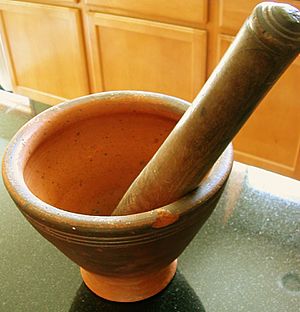
The typical Lao stove is called a tao-lo. It is a brazier fueled by charcoal. It looks like a bucket and holds one pot or pan on top. The wok, called maw khang in Lao, is used for frying. Sticky rice is steamed in a bamboo basket called a huad. This basket sits on top of a pot called a maw nung.
A large, deep mortar called a khok is used to pound tam mak hoong and other foods. It is a very important tool in a Lao kitchen.
Cooking Styles
Grilling, boiling, stewing, steaming, searing, and mixing (like in salads) are all traditional Lao cooking methods. Stir-frying is common now, but it came from Chinese cooking. Stews are often green because they use a lot of vegetables and ya nang leaf. Soups and stews have different names like tom, tom jeud, kaeng, and kaeng soua.
Ping means grilled. It is a favorite way to cook. Ping gai is grilled chicken, ping sin is grilled meat, and ping pa is grilled fish. Before grilling, meat is usually seasoned with garlic, coriander root, galangal, salt, soy sauce, and fish sauce. Lao people often grill food for a longer time at a lower heat.
This makes the grilled meat drier than what Westerners might be used to. Lao people probably like it this way because they eat grilled food with their hands and sticky rice. They also usually eat grilled food with a hot sauce called chaew, which adds moisture.
Lao food is different from food in nearby countries in a few ways. One difference is that a Lao meal almost always includes many fresh raw greens, vegetables, and herbs served on the side. Another is that savory dishes are never sweet. "Sweet and sour" is usually seen as strange in Laos. Also, some dishes are bitter. There's a Lao saying, "van pen lom; khom pen ya," which means "sweet brings you down; bitter is medicine."
Two green herbs popular in Lao cooking, but less used by neighbors, are mint and dill. Both are very important. Galangal is another herb used a lot in Laos, unlike in nearby countries. It's in most Lao dishes, along with garlic, shallots, and lemongrass. Another unique thing about Lao eating habits is that food is often eaten at room temperature. This might be because sticky rice is traditionally eaten by hand.
Eating Customs
Traditionally, people ate together, sitting on a mat on the floor around a raised platform called a ka toke. Dishes are placed on the ka toke, which is a standard size. If there are many people, several ka tokes will be set up. Each ka toke will have one or more baskets of sticky rice, which everyone at that ka toke shares.
Today, eating at a ka toke is not as common. But the custom is still kept at temples, where each monk gets his meal on a ka toke. Once food is on the ka toke, it becomes a pha kao. In modern homes, preparing the table for a meal is still called taeng pha kao, or preparing the phah kao.
In the past, spoons were only used for soups and white rice. Chopsticks (ໄມ້ທູ່, mai thu) were only used for noodles. Most food was eaten by hand. This custom likely developed because sticky rice is easiest to eat with your hands.
Lao meals usually have a soup, a grilled dish, a sauce, greens, and a stew or mixed dish (koy or laap). The greens are usually fresh raw vegetables and herbs. Sometimes they are steamed or partly boiled. Dishes are not eaten in order; the soup is sipped throughout the meal. Drinks, including water, are not usually part of the meal. When guests are present, the meal is always a big feast. There is always enough food for twice the number of people eating. For a host, not having enough food for guests would be embarrassing.
It is polite to close the rice basket when you are finished eating.
Popular Dishes
Dips
Jaew (ແຈ່ວ) is a popular type of dipping sauce in Laos.
- Jaew mak khua: Made from roasted eggplant.
- Jaew mak len: Made from roasted sweet tomatoes.
- Jaew bong: A sweet and spicy paste made with roasted chilies, pork skin, galangal, and other ingredients.
- Jaew padaek: Made from fried padaek, fish, roasted garlic, chilies, lemongrass, and other ingredients.
Appetizers

Kap kaem (ກັບແກ້ມ) are dishes served as snacks, before the main meal, or with drinks.
- Kaipen: Fried snack made of fresh water algae, usually served with jaew bong.
- Khai khuam: Stuffed eggs "upside down."
- Khai nug: Steamed or boiled egg made by mixing the yolk with other ingredients and putting it back into the shell.
- Khua pak bong: Stir-fried water spinach.
- Look seen: Laotian beef meatballs.
- Mekong river moss: Fried moss from the Mekong River.
- Sai kok: Chunky pork sausage.
- Sai oua: Grilled pork sausage.
- Seen hang: Laotian beef jerky that is quickly fried.
- Seen savanh: Thinly sliced beef jerky with a sweeter taste and covered with sesame seeds.
- Som khai pa: Pickled fish roe.
- Som moo: Pickled pork with pork skin (like summer sausages).
- Som pa: Pickled fish.
- Som phak kad: Pickled greens.
- Yaw: Laotian pork roll, also known as giò lụa in Vietnam.
- Yaw dip: A type of spring roll made with rice paper, vermicelli, lettuce, and fillings like shrimp. Eaten with peanut sauce or sweet Lao sauce.
- Yaw jeun: Fried spring roll.
Salads
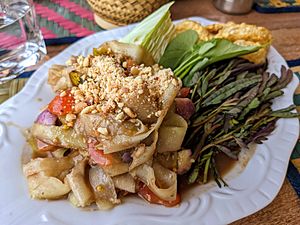
Sarad (ສະຫຼັດ) is a general name for a dish with mixed vegetables, herbs, and spices. Meat salads in Laos are called larb or laap.
- Larb: A spicy Lao minced meat salad made with fermented fish and herbs. It can use fish, duck, chicken, pork, beef, or mushrooms.
- Nam tok: A meat salad similar to larb. It can also be a stew.
- Pon: Spicy puree of cooked fish.
- Tam som: These salads are made with Lao chili peppers, lime juice, tomatoes, fish sauce/paste, and sugar. Crab paste and shrimp paste are optional.
- Tam khao poon: Spicy vermicelli noodles salad.
- Tam mak guh: Spicy plantain salad.
- Tam mak hoong: Spicy green papaya salad.
- Tum mak khua: Spicy eggplant salad.
- Tam mak taeng: Spicy cucumber salad.
- Tam mak thua: Spicy green long/yard beans salad.
Soups and Stews
Kaeng (ແກງ; meaning 'soup')
- Kaeng jeut: Vegetable and pork soup.
- Kaeng galee: Lao curry.
- Keng No Mai or soup naw mai: A green stew made with bamboo shoots.
- Or: Green vegetable stew.
- Or lam: Luang Prabang style green vegetable stew.
- Tom jeaw pa: Spicy fish soup.
- Tom kha gai: A spicy and sour soup made with coconut milk, mushrooms, and chicken.
- Tom padaek: Fish stewed in padaek.
- Tom yum: A spicy and sour soup made with lemongrass and meats like beef, chicken, pork, or seafood.
Grilled Dishes
Ahan ping (ອາຫານປີ້ງ; meaning 'grilled food')
- Ping gai: Grilled, marinated chicken.
- Ping hua ped: Grilled, marinated duck head.
- Ping moo: Grilled, marinated pork.
- Ping pa: Grilled fish mixed with spices and herbs.
- Ping ped: Grilled, marinated duck.
- Ping seen: Grilled, marinated beef.
- Ping theen gai: Grilled, marinated chicken feet.
- Seen dat: Laotian-style barbecue. Meats and vegetables are cooked on a dome-shaped griddle.
Steamed Dishes
Ahan neung (ອາຫານຫນື້ງ; meaning 'steamed food')
- Mok pa: Fish steamed in a banana leaf.
- Mok gai: Chicken steamed in a banana leaf.
- Titi gai: Steak in a banana leaf wrap.
Rice Dishes
Ahan kap khao (ອາຫານກັບເຂົ້າ; meaning 'food with rice'). These dishes use rice as the main ingredient. In most Lao meals, glutinous rice, called khao niao, is a main food.
- Khao khua or khao phat: Laotian-style fried rice.
- Khao niao: Steamed glutinous rice, also known as "sticky rice." It's usually kept in a bamboo basket and shared by everyone. Sweet ingredients like coconut milk and red beans can be added to make it a dessert.
- Khao piak khao: Rice porridge. Toppings can include blood curds, century eggs, fried onions or garlic, and scallions.
- Khao ping or khao chee: Baked sticky rice seasoned with eggs. Khao chee is also a name for bread.
- Khao jao or khao neung: Steamed white rice. Jasmine rice is often used. This rice is also an ingredient for many stir-fried dishes.
- Nam khao: Crispy rice salad made with deep-fried rice balls, fermented pork sausage (som moo), chopped peanuts, grated coconut, and herbs.
Noodles
Feu (ເຝີ) or Mee (ໝີ່). Noodles are popular in northern and central Laos. They can be "wet noodles" served with broth, or "dry noodles" which are usually stir-fried.
- Feu: Laotian-style Pho, or rice noodle soup.
- Kaeng sen lon: Soup made with glass noodles and meatballs.
- Khao piak sen: Rice flour noodles in chicken broth.
- Khao poon: Rice vermicelli soup, also known as "Lao laksa".
- Khua mee: Pan-fried rice noodles topped with thinly sliced egg omelette.
- Lard na: Stir-fried noodles covered in gravy.
- Mee haeng: Wheat noodles with vegetables and meat.
- Mee nam: Wheat noodles in a broth of vegetables and meat.
- Pad Lao: Stir-fried noodles mixed with lightly scrambled egg. Similar to Pad Thai.
- Pad ki mao: Stir-fried broad rice noodles.
- Pad sen lon: Stir-fried glass noodles.
- Suki: Laotian-style Sukiyaki.
- Yum sen lon: Tangy salad made with glass noodles.
Breads
Bread originally came from France, but it is very popular. The most common type is small baguettes, known as (ເຂົ້າຈີ່, khao chi).
- Khao chi pate (ເຂົ້າຈີ່ປາເຕ້): A baguette stuffed with pâté and other ingredients. It's the Lao version of banh mi.
Desserts
Khong van (ຂອງຫວານ; meaning 'sweet things'). Lao desserts are usually made with tropical fruits and sticky rice products. These can be cakes, jelly, drinks, and custards.
- Khao lam: A sweet sticky rice dish made with red beans, coconut, coconut milk, and sugar. It's cooked in bamboo.
- Khao niao mak muang: Sticky rice with coconut and mango.
- Khao pard: A jelly-like rice cake, known for its layers. It's often green from pandan leaves.
- Khao tom: Steamed rice wrapped in a banana leaf. Fillings can include pork, bananas, and taro.
- Khanom kok: Coconut dumpling made on a griddle. It might have green onions on top.
- Khanom maw kaeng: Coconut custard cake.
- Lod xong: A green, worm-like dessert made with rice jelly, coconut milk, and liquid palm sugar.
- Nam van: A general name for a dessert that can have tapioca and fruits like durian, jackfruit, and water chestnuts.
- Sangkaya: Custard made with Kabocha, a type of Asian squash.
- Voon: Jelly made with coconut milk.
Drinks
Lao coffee is often called Pakxong coffee (cafe pakxong in Lao). It grows on the Bolovens Plateau around the town of Pakxong. This area is thought to be one of the best places in Southeast Asia to grow coffee. Both Robusta and Arabica coffee are grown in Laos. Most Arabica coffee in Laos is used locally. Most Robusta is sent to Thailand for Nescafé. In Laos, people usually drink coffee in glasses with condensed milk at the bottom. They often have a small glass of green tea afterwards. Good quality tea is also grown on the Bolovens Plateau.
- Ca fay: Laotian coffee.
- Nam oi: Sugarcane juice.
- Nam pun: Smoothie.
- Nam mak pow: Coconut juice, with or without coconut meat.
- Oliang: Iced coffee; black or with condensed milk.
- Saa: Laotian tea.
See also
 In Spanish: Gastronomía de Laos para niños
In Spanish: Gastronomía de Laos para niños


